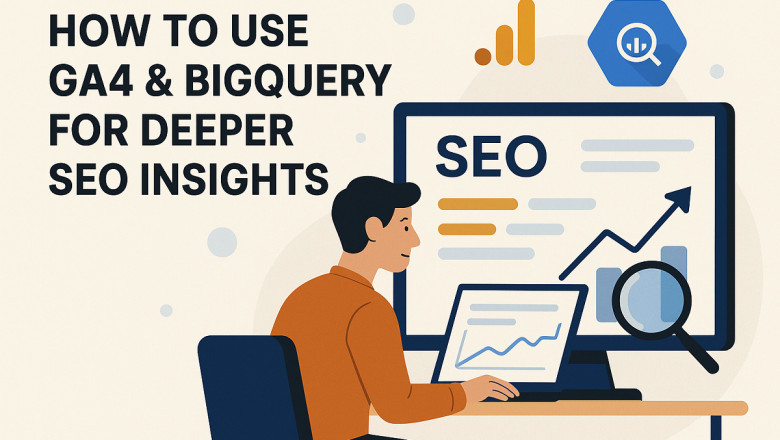views
In today’s data-driven world, businesses that invest in SEO services in Abu Dhabi expect more than just rankings—they want insights that drive real results. With the shift from Universal Analytics to Google Analytics 4 (GA4), and the power of BigQuery integration, SEO professionals now have access to a whole new level of data granularity. Together, GA4 and BigQuery unlock deeper SEO insights that can transform how you analyze performance, optimize content, and forecast growth.
But how do you actually leverage these tools in tandem for SEO? Let’s break it down.
Why GA4 Is a Game-Changer for SEO
GA4 marks a major evolution in how Google collects and organizes data. Unlike its predecessor, GA4 uses an event-based model rather than a session-based one. This means you’re no longer limited to pageviews and sessions—you can track virtually any user interaction: scroll depth, file downloads, video plays, form submissions, and more.
Key SEO Benefits of GA4:
-
Improved engagement tracking: Understand how users interact with specific SEO landing pages.
-
Cross-platform data: See how users behave across web and mobile apps.
-
Enhanced user journey tracking: Map user behavior from acquisition to conversion.
But while GA4 gives you valuable insights, it has limitations in terms of interface flexibility and data retention. That’s where BigQuery steps in.
What Is BigQuery and Why Use It?
BigQuery is Google Cloud’s enterprise-level data warehouse. When connected to GA4, it allows you to store, query, and analyze raw data far beyond GA4’s standard reporting limitations.
With BigQuery, you can:
-
Query trillions of rows of data using SQL
-
Join GA4 data with external datasets (like CRM, email, or ad data)
-
Retain and access historical data without sampling
-
Build predictive models using machine learning
For SEOs, this means the ability to explore advanced queries, analyze performance over longer periods, and get insights that aren't visible in GA4 alone.
Setting Up GA4 + BigQuery for SEO
Before you can start mining deeper SEO insights, you need to link GA4 to BigQuery:
-
Go to Admin in GA4
-
Under "Property," click on “BigQuery Linking”
-
Create a new link and connect it to your Google Cloud project
-
Choose the data stream and configure the frequency (daily or streaming)
-
Save and wait for data to start populating in BigQuery
Once setup is complete, your raw GA4 data will flow into BigQuery, organized in tables by event.
Key SEO Questions You Can Answer with BigQuery
BigQuery allows you to answer complex SEO questions that GA4 alone can’t. Here are a few use cases:
1. Which landing pages bring the highest engaged sessions?
SELECT
page_location,
COUNT(DISTINCT user_pseudo_id) AS unique_users,
COUNT(*) AS total_events
FROM
`your_dataset.events_*`
WHERE
event_name = 'session_start'
GROUP BY
page_location
ORDER BY
total_events DESC
LIMIT 10
This helps identify which pages attract not just traffic, but high-quality user interactions—valuable for optimizing content strategy.
2. Which traffic sources lead to the most conversions?
Combine your session_start and conversion events to see which SEO-driven sources lead to meaningful results. You can also distinguish organic traffic by using source = 'google' and medium = 'organic'.
3. What keywords or search terms result in low engagement?
While GA4 doesn’t provide full keyword data (due to privacy), you can link it with Google Search Console data and cross-reference it in BigQuery to find patterns in low-engagement queries.
Advanced Use Cases
Once you're comfortable with basic queries, you can start experimenting with more advanced tactics:
Predictive Analytics:
Use BigQuery ML to train models on historical data and predict future traffic trends or identify pages at risk of decline.
SEO A/B Testing:
Query behavior metrics from different landing pages to measure performance variations and test hypotheses more effectively than standard split tests.
Content Cluster Analysis:
Segment your content into thematic clusters (e.g., by URL structure or topic tag), and analyze metrics across each group to determine which topic areas perform best in terms of traffic, engagement, and conversions.
Tips for Getting the Most Out of GA4 & BigQuery
-
Use Looker Studio (formerly Data Studio): Visualize your BigQuery results in a clean, client-friendly dashboard.
-
Schedule queries: Automate reports with scheduled queries that run daily or weekly.
-
Use filters wisely: Clean your data to exclude bots, internal traffic, and anomalies for more accurate insights.
-
Document everything: As your queries become more complex, keep documentation to make your analysis replicable and understandable for other team members.
GA4 and BigQuery together provide a powerful toolkit for SEO professionals ready to go beyond surface-level metrics. With the ability to analyze raw, unsampled data and customize reports to your specific needs, you can uncover deeper insights that directly impact your strategy and results.
For businesses serious about performance and precision, integrating GA4 with BigQuery should be a core part of any modern analytics stack. If you’re working with or considering SEO services in Sharjah, make sure they’re equipped to harness the full potential of these tools to elevate your search strategy and ROI.













Comments
0 comment